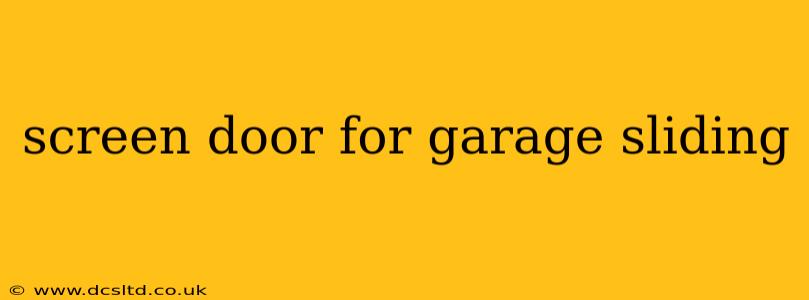A sliding garage door screen can transform your garage into a versatile outdoor space, extending your living area and providing protection from pesky insects. But choosing the right screen can be tricky. This guide will walk you through everything you need to know about selecting and installing a screen door for your sliding garage door.
What are the different types of sliding garage door screens?
There are several types of screens available, each with its own pros and cons:
-
Retractable Screens: These screens roll up and disappear neatly into a cassette when not in use. They're a great option for preserving a clean look when the screen isn't needed. They are often more expensive than other options but offer convenience and ease of use.
-
Sliding Panel Screens: These screens slide along tracks, similar to the garage door itself. They are usually more affordable than retractable screens and offer a good balance between cost and functionality. However, they require more storage space when not in use.
-
Magnetic Screens: These screens use magnets to hold them in place. They’re easy to install and remove, making them a convenient option for temporary use. However, they might not be as durable or weather-resistant as other types.
-
Custom-Made Screens: If you have a uniquely sized or shaped garage door, a custom-made screen might be necessary. This will usually be the most expensive option but ensures a perfect fit.
How much does a sliding garage door screen cost?
The cost of a sliding garage door screen varies greatly depending on the type of screen, size, and materials. Retractable screens tend to be the most expensive, while magnetic screens are generally the least expensive. You can expect to pay anywhere from a few hundred dollars to over a thousand dollars, depending on your choice.
What are the best materials for a sliding garage door screen?
The most common materials for garage door screens are fiberglass and vinyl-coated polyester. Fiberglass is strong and durable, while vinyl-coated polyester is more resistant to tearing and stretching. Consider the climate you live in when choosing a material; vinyl-coated polyester may be preferable in areas with harsh weather conditions.
How difficult is it to install a sliding garage door screen?
The difficulty of installation depends heavily on the type of screen you choose. Magnetic screens are the easiest to install, while retractable and sliding panel screens may require more time and some basic DIY skills. Some screens require drilling into the door frame, while others attach with adhesive or clips. Always follow the manufacturer's instructions carefully.
How do I measure my garage door for a screen?
Accurate measurement is crucial for a proper fit. Measure the width and height of your garage door opening precisely. Consider any existing tracks or obstructions that might affect the screen's installation. It's always best to double-check your measurements before purchasing a screen.
Can I install a screen door on a sectional garage door?
Installing a screen on a sectional garage door is significantly more challenging than on a sliding door. It's often impractical and requires significant modification to the garage door system, potentially voiding any warranties. While not impossible, it's best to consult a professional installer for advice on such a complex project.
How do I maintain my sliding garage door screen?
Regular maintenance will extend the life of your screen. Clean the screen regularly with mild soap and water. Inspect the tracks and hardware regularly for any damage or wear. Repair or replace any damaged parts promptly. Proper maintenance will ensure your screen continues to provide years of service.
This guide provides a starting point for your research. Remember to always check reviews and compare prices before making a purchase. Happy screening!
